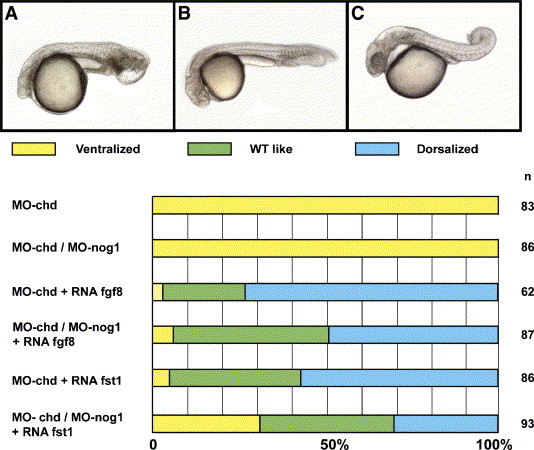Fig. 7 Fgf8 and Fst1 overexpression rescues chordin and chordin–noggin1 morphants. (A) Example of a ventralization phenotype observed after injection of chd or chd-nog1 morpholinos. (B) Example of wild-type like morphology obtained after injection of fgf8 or fst1 RNA into chd or chd-nog1 morphants (C). Example of a dorsalization phenotype observed after injection of fgf8 or fst1 RNA into chd or chd-nog1 morphants. Embryos are observed at 30 hpf in lateral view, anterior to the left. Lower panel: the horizontal bars represent the percentage of embryos displaying a ventralized phenotype (yellow), a wild-type like morphology (green) or a dorsalized phenotype (blue) in chd morphants (MO-chd, 100 μM), double chd-nog1 morphants (MO-chd/MO-nog1—100 μM/800 μM), in chd or chd-nog1 morphants injected with 5 pg of fgf8 RNA (MO-chd + RNA fgf8; MO-chd/MO-nog1 + RNA fgf8, respectively) or with 50 pg of fst1 RNA (MO-chd + RNA fst1; MO-chd/MO-nog1 + RNA fst1, respectively). Due to the lack of two Bmp inhibitors, the rescue of ventralization phenotype (wild-type-like and dorsalized phenotypes) by fgf8 and fst1 is less efficient in double chd-nog1 morphants than in single chd morphants. n: number of embryos analyzed.
Reprinted from Developmental Biology, 298(2), Dal-Pra, S., Fürthauer, M., Van-Celst, J., Thisse, B., and Thisse, C., Noggin1 and Follistatin-like2 function redundantly to Chordin to antagonize BMP activity, 514-526, Copyright (2006) with permission from Elsevier. Full text @ Dev. Biol.

